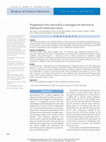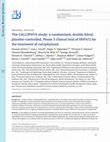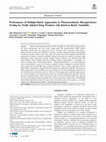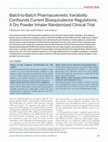Papers by Kevin J Carroll
This copy of the thesis has been supplied on condition that anyone who consults it is understood ... more This copy of the thesis has been supplied on condition that anyone who consults it is understood to recognise that its copyright rests with the author and that use of any information derived there from must be in accordance with current UK Copyright Law. In addition, any quotation or extract must include full attribution.

Nephrology Dialysis Transplantation, 2020
Data directly demonstrating the relationship between urinary oxalate (UOx) excretion and stone ev... more Data directly demonstrating the relationship between urinary oxalate (UOx) excretion and stone events in those with enteric hyperoxaluria (EH) are limited. Therefore, we assessed the relationship between UOx excretion and risk of kidney stone events in a retrospective population-based EH cohort. In all, 297 patients from Olmsted County, Minnesota were identified with EH based upon having a 24-h UOx ≥40 mg/24 h preceded by a diagnosis or procedure associated with malabsorption. Diagnostic codes and urologic procedures consistent with kidney stones during follow-up after baseline UOx were considered a new stone event. Logistic regression and accelerated failure time modeling were performed as a function of UOx excretion to predict the probability of new stone event and the annual rate of stone events, respectively, with adjustment for urine calcium and citrate. Mean ± standard deviation age was 51.4 ± 11.4 years and 68% were female. Median (interquartile range) UOx was 55.4 (46.6–73.0...

American Journal of Kidney Diseases, 2016
Background: The role of change in proteinuria as a surrogate end point for randomized trials in i... more Background: The role of change in proteinuria as a surrogate end point for randomized trials in immunoglobulin A nephropathy (IgAN) has previously not been thoroughly evaluated. Study Design: Individual patient-level meta-analysis. Setting & Population: Individual-patient data for 830 patients from 11 randomized trials evaluating 4 intervention types (renin-angiotensin system [RAS] blockade, fish oil, immunosuppression, and steroids) examining associations between changes in urine protein and clinical end points at the individual and trial levels. Selection Criteria for Studies: Randomized controlled trials of IgAN with measurements of proteinuria at baseline and a median of 9 (range, 5-12) months follow-up, with at least 1 further year of follow-up for the clinical outcome. Predictor: 9-month change in proteinuria. Outcome: Doubling of serum creatinine level, end-stage renal disease, or death. Results: Early decline in proteinuria at 9 months was associated with lower risk for the clinical outcome (HR per 50% reduction in proteinuria, 0.40; 95% CI, 0.32-0.48) and was consistent across studies. Proportions of treatment effect on the clinical outcome explained by early decline in proteinuria were estimated at 11% (95% CI, 219% to 41%) for RAS blockade and 29% (95% CI, 6% to 53%) for steroid therapy. The direction of the pooled treatment effect on early change in proteinuria was in accord with the direction of the treatment effect on the clinical outcome for steroids and RAS blockade. Trial-level analyses estimated that the slope for the regression line for the association of treatment effects on the clinical end points and for the treatment effect on proteinuria was 2.15 (95% Bayesian credible interval, 0.10-4.32). Limitations: Study population restricted to 11 trials, all having fewer than 200 patients each with a limited number of clinical events. Conclusions: Results of this analysis offer novel evidence supporting the use of an early reduction in proteinuria as a surrogate end point for clinical end points in IgAN in selected settings.

Prostate Cancer and Prostatic Diseases, 2001
Castration is the most widely used form of androgen ablation employed in the treatment of metasta... more Castration is the most widely used form of androgen ablation employed in the treatment of metastatic (M1) prostate cancer. Non-steroidal antiandrogen monotherapy is a potential alternative treatment option for men for whom castration is unacceptable or not indicated. Of the three non-steroidal antiandrogens, bicalutamide ('Casodex'), flutamide and nilutamide, only bicalutamide has been compared with castration in large, controlled, randomised, Phase III trials in M1 patients. A post-hoc analysis of these studies indicated that bicalutamide 150 mg/day monotherapy may be of benefit to M1 patients with a prostate specific antigen (PSA) level 400 ng/ml. Significant advantages for M1 patients treated with bicalutamide were observed in subjective response rate, maintenance of sexual interest and physical capacity. Patients with a higher disease burden (PSA > 400 ng/ml) may decide that quality of life and symptomatic benefits outweigh the slight survival disadvantage seen in clinical trials and opt for bicalutamide monotherapy as an alternative to castration.

Journal of Clinical Oncology, 2007
Purpose The traditional end point for assessing efficacy of first-line chemotherapies for advance... more Purpose The traditional end point for assessing efficacy of first-line chemotherapies for advanced cancer is overall survival (OS), but this end point requires prolonged follow-up and is potentially confounded by the effects of second-line therapies. We investigated whether progression-free survival (PFS) could be considered a valid surrogate for OS in advanced colorectal cancer. Patients and Methods Individual patient data were available from 10 historical trials comparing fluouracil (FU) + leucovorin with either FU alone (1,744 patients) or with raltitrexed (1,345 patients) and from three validation trials comparing FU + leucovorin with or without irinotecan or oxaliplatin (1,263 patients). Correlation coefficients were estimated in historical trials between the end points of PFS and OS, and between the treatment effects on these end points. Treatment effects on OS were predicted in validation trials, and compared with the observed effects. Results In historical trials, 1,760 pati...

Circulation, 2011
Background— In the Platelet Inhibition and Patient Outcomes (PLATO) trial, a prespecified subgrou... more Background— In the Platelet Inhibition and Patient Outcomes (PLATO) trial, a prespecified subgroup analysis showed a significant interaction between treatment and region ( P =0.045), with less effect of ticagrelor in North America than in the rest of the world. Methods and Results— Reasons for the interaction were explored independently by 2 statistical groups. Systematic errors in trial conduct were investigated. Statistical approaches evaluated the likelihood of play of chance. Cox regression analyses were performed to quantify how much of the regional interaction could be explained by patient characteristics and concomitant treatments, including aspirin maintenance therapy. Landmark Cox regressions at 8 time points evaluated the association of selected factors, including aspirin dose, with outcomes by treatment. Systematic errors in trial conduct were ruled out. Given the large number of subgroup analyses performed and that a result numerically favoring clopidogrel in at least 1 ...

Clinical Pharmacology & Therapeutics, 2016
We previously demonstrated pharmacokinetic differences among manufacturing batches of a US Food a... more We previously demonstrated pharmacokinetic differences among manufacturing batches of a US Food and Drug Administration (FDA)-approved dry powder inhalation product (Advair Diskus 100/50) large enough to establish betweenbatch bio-inequivalence. Here, we provide independent confirmation of pharmacokinetic bio-inequivalence among Advair Diskus 100/50 batches, and quantify residual and between-batch variance component magnitudes. These variance estimates are used to consider the type I error rate of the FDA's current two-way crossover design recommendation. When between-batch pharmacokinetic variability is substantial, the conventional two-way crossover design cannot accomplish the objectives of FDA's statistical bioequivalence test (i.e., cannot accurately estimate the test/reference ratio and associated confidence interval). The two-way crossover, which ignores between-batch pharmacokinetic variability, yields an artificially narrow confidence interval on the product comparison. The unavoidable consequence is type I error rate inflation, tõ 25%, when between-batch pharmacokinetic variability is nonzero. This risk of a false bioequivalence conclusion is substantially higher than asserted by regulators as acceptable consumer risk (5%).

Clinical Kidney Journal, 2021
Background Calcific uraemic arteriolopathy (CUA; calciphylaxis) is a rare disease seen predominan... more Background Calcific uraemic arteriolopathy (CUA; calciphylaxis) is a rare disease seen predominantly in patients receiving dialysis. Calciphylaxis is characterized by poorly healing or non-healing wounds, and is associated with mortality, substantial morbidity related to infection and typically severe pain. In an open-label Phase 2 clinical trial, SNF472, a selective inhibitor of vascular calcification, was well-tolerated and associated with improvement in wound healing, reduction of wound-related pain and improvement in wound-related quality of life (QoL). Those results informed the design of the CALCIPHYX trial, an ongoing, randomized, placebo-controlled, Phase 3 trial of SNF472 for treatment of calciphylaxis. Methods In CALCIPHYX, 66 patients receiving haemodialysis who have an ulcerated calciphylaxis lesion will be randomized 1:1 to double-blind SNF472 (7 mg/kg intravenously) or placebo three times weekly for 12 weeks (Part 1), then receive open-label SNF472 for 12 weeks (Part 2...

AAPS PharmSciTech, 2021
Batch-to-batch pharmacokinetic (PK) variability of orally inhaled drug products has been document... more Batch-to-batch pharmacokinetic (PK) variability of orally inhaled drug products has been documented and can render single-batch PK bioequivalence (BE) studies unreliable; results from one batch may not be consistent with a repeated study using a different batch, yet the goal of PK BE is to deliver a product comparison that is interpretable beyond the specific batches used in the study. We characterized four multiple-batch PK BE approaches to improve outcome reliability without increasing the number of clinical study participants. Three approaches include multiple batches directly in the PK BE study with batch identity either excluded from the statistical model (“Superbatch”) or included as a fixed or random effect (“Fixed Batch Effect,” “Random Batch Effect”). A fourth approach uses a bio-predictive in vitro test to screen candidate batches, bringing the median batch of each product into the PK BE study (“Targeted Batch”). Three of these approaches (Fixed Batch Effect, Superbatch, T...

Pharmaceutical statistics, 2018
The longitudinal data from 2 published clinical trials in adult subjects with upper limb spastici... more The longitudinal data from 2 published clinical trials in adult subjects with upper limb spasticity (a randomized placebo-controlled study [NCT01313299] and its long-term open-label extension [NCT01313312]) were combined. Their study designs involved repeat intramuscular injections of abobotulinumtoxinA (Dysport®), and efficacy endpoints were collected accordingly. With the objective of characterizing the pattern of response across cycles, Mixed Model Repeated Measures analyses and Non-Linear Random Coefficient (NLRC) analyses were performed and their results compared. The Mixed Model Repeated Measures analyses, commonly used in the context of repeated measures with missing dependent data, did not involve any parametric shape for the curve of changes over time. Based on clinical expectations, the NLRC included a negative exponential function of the number of treatment cycles, with its asymptote and rate included as random coefficients in the model. Our analysis focused on 2 specific...

Journal of Clinical Oncology, 2004
4652 Background: It is a common misconception that a correlation between endpoints is enough to d... more 4652 Background: It is a common misconception that a correlation between endpoints is enough to demonstrate surrogacy. To show true surrogacy, the effect of an intervention on an intermediate endpoint relative to a control treatment needs to reliably predict the effect of the intervention on the clinical outcome of interest. Valid surrogate endpoints are needed to accelerate availability of information about new therapies for early prostate cancer where clinical progression and survival times are prolonged. The usefulness of prostate-specific antigen (PSA) progression as a surrogate for objective clinical progression has therefore been assessed in the bicalutamide ('Casodex') Early Prostate Cancer (EPC) Program, the world's largest prostate cancer treatment program. METHODS Individual data from all 8113 patients across 21 countries in the EPC Program were examined. Time to PSA progression and time to objective clinical progression were the endpoints evaluated. The effect of treatment on time to PSA progression was compared with the effect of treatment on time to objective clinical progression. RESULTS Analyses suggest that time to PSA progression is a modest surrogate endpoint for the effect of a hormonal intervention on objectively confirmed progression in patients with early prostate cancer (r2 = 0.52-0.65, p<0.001). An intervention that produces around a 50% reduction in the risk of PSA progression would likely result in around a 20% reduction in the risk of objective clinical progression. CONCLUSIONS The effect of treatment on PSA progression is moderately predictive for the effect of hormonal treatment on objective clinical progression. A large effect on PSA progression predicts for a smaller, but nonetheless clinically important effect on objective clinical progression. These data suggest that a large positive treatment effect on time to PSA progression is reasonably likely to reflect a clinically important delay in objective clinical progression, making PSA progression a valid endpoint for the evaluation of hormonal medicines in early prostate cancer. 'Casodex' is a trademark of the AstraZeneca group of companies. [Table: see text].

Drug Information Journal, 2011
The Japanese regulatory guideline “Basic Principles in Global Clinical Trials,” issued in Septemb... more The Japanese regulatory guideline “Basic Principles in Global Clinical Trials,” issued in September 2007, serves to encourage the participation of Japan in international phase 3 clinical trials and, as such, is very much welcome, helping to avoid repeat, stand-alone trials in Japanese patients that are often underpowered. However, the guideline raises a concern regarding the consistency of outcomes in the subset of Japanese patients and the total trial population and offers two alternative criteria to determine the fraction of Japanese patients that should be recruited. The first criterion requires that sufficient Japanese patients are entered such that, if the treatment effects in the Japanese and overall populations are truly the same, there is an 80% chance that the effect in Japanese patients will be shown to be at least half of the effect in the total trial population. The second criterion requires that sufficient patients be entered per geographical region included in the trial such that, if there is a true effect in the overall population, the probability that each region (including Japan) will also show a positive effect is 80%. The purpose of this article is to explore the implications of these criteria in terms of overall power and the fraction of the Japanese patients that need to be recruited to satisfy them and to consider some potential alternative criteria that might offer advantages over those stated in the guideline.

Clinical Pharmacology & Therapeutics, 2016
Current pharmacokinetic (PK) bioequivalence guidelines do not account for batch-to-batch variabil... more Current pharmacokinetic (PK) bioequivalence guidelines do not account for batch-to-batch variability in study design or analysis. Here we evaluate the magnitude of batch-to-batch PK variability for Advair Diskus 100/50. Single doses of fluticasone propionate and salmeterol combinations were administered by oral inhalation to healthy subjects in a randomized clinical crossover study comparing three different batches purchased from the market, with one batch replicated across two treatment periods. All pairwise comparisons between different batches failed the PK bioequivalence statistical test, demonstrating substantial PK differences between batches that were large enough to demonstrate bio-inequivalence in some cases. In contrast, between-replicate PK bioequivalence was demonstrated for the replicated batch. Between-batch variance was~40-70% of the estimated residual error. This large additional source of variability necessitates re-evaluation of bioequivalence assessment criteria to yield a result that is both generalizable and consistent with the principles of type I and type II error rate control.

Pharmaceutical statistics
In oncology, it may not always be possible to evaluate the efficacy of new medicines in placebo-c... more In oncology, it may not always be possible to evaluate the efficacy of new medicines in placebo-controlled trials. Furthermore, while some newer, biologically targeted anti-cancer treatments may be expected to deliver therapeutic benefit in terms of better tolerability or improved symptom control, they may not always be expected to provide increased efficacy relative to existing therapies. This naturally leads to the use of active-control, non-inferiority trials to evaluate such treatments. In recent evaluations of anti-cancer treatments, the non-inferiority margin has often been defined in terms of demonstrating that at least 50% of the active control effect has been retained by the new drug using methods such as those described by Rothmann et al., Statistics in Medicine 2003; 22:239-264 and Wang and Hung Controlled Clinical Trials 2003; 24:147-155. However, this approach can lead to prohibitively large clinical trials and results in a tendency to dichotomize trial outcome as eithe...
Statistics in Biopharmaceutical Research, 2013

Statistics in Biopharmaceutical Research, 2013
Active-controlled, “noninferiority” (NI) trials continue to raise many issues and controversies. ... more Active-controlled, “noninferiority” (NI) trials continue to raise many issues and controversies. With placebo-controlled trials becoming increasingly difficult in areas like oncology, infection, arthritis and respiratory illness, the use of active-controlled, “NI” trials to evaluate new treatments is likely to continue to be an important feature of drug development. Such trials continue to pose fundamental issues, many of which remain without broad scientific or regulatory consensus. These issues range from the fundamental purpose of an active-controlled NI trial to determination of the effectiveness of control and sample size, to issues of assay sensitivity and trial quality, to the statistical methodologies to be used. In this article, these matters are reviewed and discussed and observations are offered regarding the relative merits of the most common methodologies currently in use for NI assessment. Opinions are also included occasionally, some perhaps controversial, with the intention of generating discussion and debate.
Statistics in Biopharmaceutical Research, 2010
The double-blind placebo-controlled trial is the established standard for determining the efficac... more The double-blind placebo-controlled trial is the established standard for determining the efficacy of an experimental treatment. However, there are circumstances where the use of a placebo is unethical or impractical, and active-controlled trials are a common alternative. ...

Pharmaceutical Statistics, 2007
With the advent of ever more effective second and third line cancer treatments and the growing us... more With the advent of ever more effective second and third line cancer treatments and the growing use of &amp;amp;amp;amp;amp;amp;amp;amp;amp;amp;amp;amp;amp;amp;amp;amp;#39;crossover&amp;amp;amp;amp;amp;amp;amp;amp;amp;amp;amp;amp;amp;amp;amp;amp;#39; trial designs in oncology, in which patients switch to the alternate randomized treatment upon disease progression, progression-free survival (PFS) is an increasingly important endpoint in oncologic drug development. However, several concerns exist regarding the use of PFS as a basis to compare treatments. Unlike survival, the exact time of progression is unknown, so progression times might be over-estimated and, consequently, bias may be introduced when comparing treatments. Further, it is not uncommon for randomized therapy to be stopped prior to progression being documented due to toxicity or the initiation of additional anti-cancer therapy; in such cases patients are frequently not followed further for progression and, consequently, are right-censored in the analysis. This article reviews these issues and concludes that concerns relating to the exact timing of progression are generally overstated, with analysis techniques and simple alternative endpoints available to either remove bias entirely or at least provide reassurance via supportive analyses that bias is not present. Further, it is concluded that the regularly recommended manoeuvre to censor PFS time at dropout due to toxicity or upon the initiation of additional anti-cancer therapy is likely to favour the more toxic, less efficacious treatment and so should be avoided whenever possible.
Pharmaceutical Statistics, 2008
Applied Statistics, volume 57, parts 1 and 2. Biometrical Journal, volume 49, issue 6, and volume... more Applied Statistics, volume 57, parts 1 and 2. Biometrical Journal, volume 49, issue 6, and volume 50, issue 1. Biometrics, volume 63, part 4, and volume 64, issue 1. Biometrika, volume 94, issue 4, and volume 95, issue 1. Biostatistics, volume 9, part 1. Clinical Trials, volume 5, part 1. Drug Information Journal, volume 41, part 6, and volume 41, parts 1–2. Journal of Biopharmaceutical Statistics, volume 18, part 1. Journal of the Royal Statistical Society, Series A, volume 171, part 1. Statistics in Medicine, volume 26, part 30, and volume 27, parts 1–8.

Uploads
Papers by Kevin J Carroll